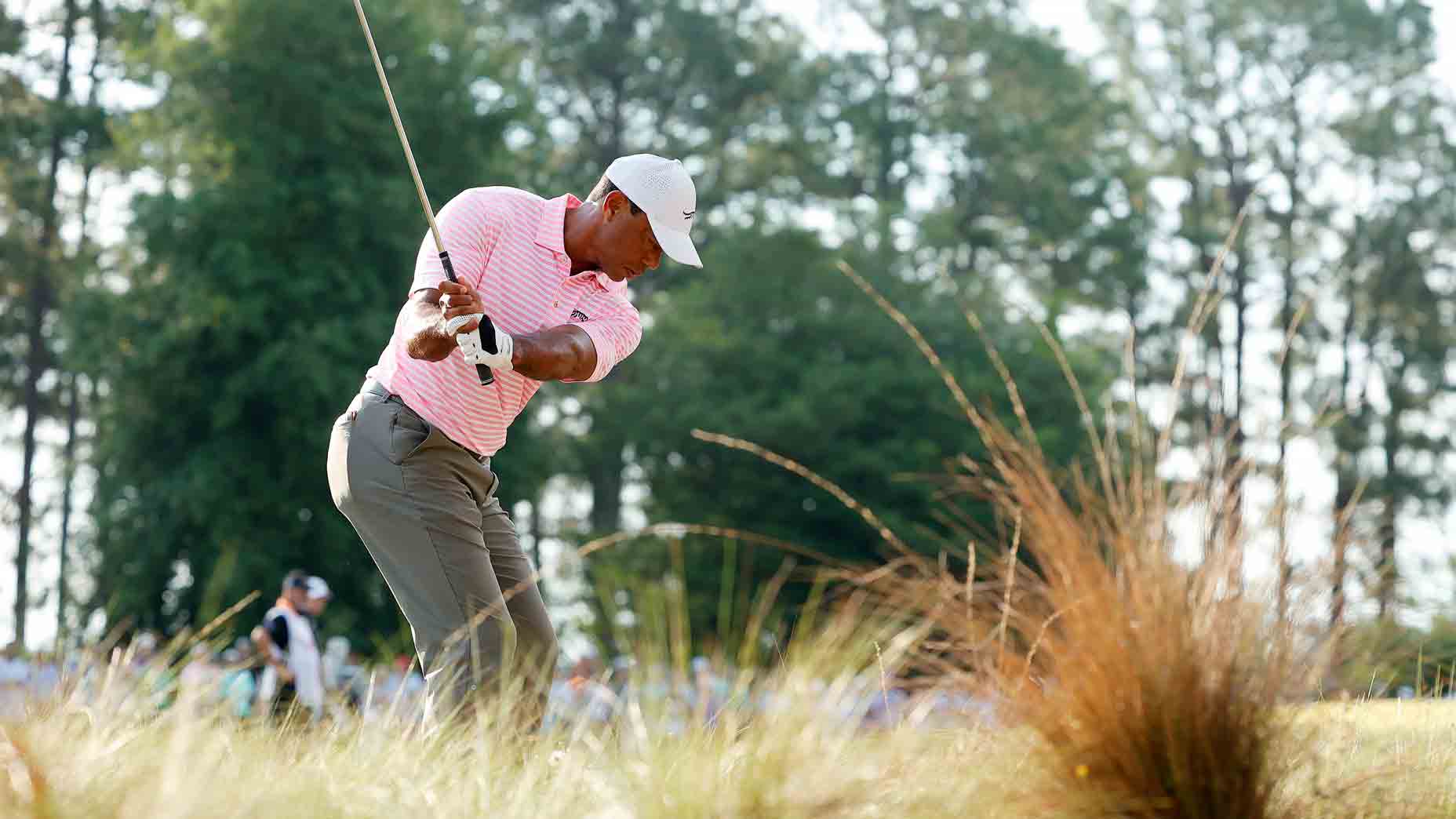PINEHURST, N.C. — Josh Radcliff, in the gloaming on Monday, during a practice round for this week’s U.S. Open, nearly dunked an iron on Pinehurst’s par-3 9th. So close was it to going in for a one that Radcliff’s caddie, his dad Phillip, asked a few workers around the green whether they thought it had a chance.
You can have those kinds of moments here.
And you can also struggle to advance a ball from the thick stuff right of the 2nd fairway, and you can short a bunker shot on 3, and you can chip a couple times on 8, all of which Radcliff did, too.
Pinehurst No. 2 is occasionally generous, and it’s frequently stingy, as Radcliff learned. Notably, the 29-year-old pro, an alternate this week, was also making his first-ever trip around the track ranked 21st in GOLF’s ranking of the top 100 courses in the world — and his freshness made him an interesting source for an always engaging topic come major-championship time.
What would a 15-handicap shoot at Pinehurst under U.S. Open conditions?
Radcliff said triple digits.
“A 15-handicap set up for the U.S. Open is no way breaking 100,” he said. “Playing U.S. Open tees, man. I’d say they shoot 110.”
One-hundred ten?
“That’s my guess,” Radcliff said. “Yeah, it’s a different type of — I mean, if they’ve played it a whole bunch and they’re familiar with where to put it, maybe they could do all right and they’d shoot around 100. But 15-handicapper that’s only seen the course once maybe, you’ll have no chance.” (The USGA’s Pinehurst No. 2 target score calculator indicates a 15-handicapper might do a few shots better, clocking in at a 97.)
What makes No. 2 so hard?
The approach shots, Radcliff said — and the greens that repel them.
“It’s the approach shots into the greens because you’re hitting it into such a small area where you have run-offs left and right,” Radcliff said. “I was talking with my dad, my caddie, walking up the 8th hole, it’s like, if you work toward the middle of the green from the edges of the green, you have a little bit of a better chance to hold because there are all these turtlebacks. So you’re coming in from right to left and you hit the right-center of the green, you’re going to end up good.
“But if you cross the center of the green, then you got a right-to-left shot landing on a right-to-left slope and you can’t hold it because it’s so firm. Then it rolls all the way down, 15 yards off the green, and you’re faced with this odd, do I bump it into the hill, do I try to putt it up through the fairway, which is into the grain. And then once you crest the hill, it’s typically a little bit of a downhill — the ball just rolls downhill from there so it’s tough to judge once you get off and you’re pin high. I think guys that are going to leave it short of pin high are going to have a little bit more into the slope to work with on either their chip or putt from the fairway area to be able to end up having a better chance.
“It’s definitely tricky because you don’t really see it on any other golf course. So you don’t really get a chance to practice it a whole ton.”
His hardest hole? Some of the par-3s, Radcliff said. “No. 6 is a 245-yard par-3 with a 10-yard-wide green. Playing 245, I had to hit a 5-wood to … a 10-yard-wide gap and I got to be distance perfect because there’s such a massive false front.” The lengthy par-4s were similarly difficult.
All of which speaks to what’s needed most at Pinehurst, Radcliff thought.
“More mental fortitude than specific shot,” he said. “Because you can hit great shots and then end up in a bad spot. So it’s the guy that will stay patient and enjoy the challenge. I think of guys with really creative short games that are really good at sinking clutch par putts. You know, again, I think that’s kind of a mental thing; I don’t know if there’s any sort of statistic on anything like that. Some guys that just seem to relish the opportunity of hey, let me show off here or let me get this tough one up and down. Those are the guys that I think are going to play well.
“I think, honestly, guys that don’t curve the ball a lot, which are a lot of players these days, they’re going to have a good shot with those approach shots into the greens. If you’re coming down landing into the green without curve, you’ve got a better shot of holding the green.”
Back to being patient for a sec.
It’s a thought that’s tossed around a lot — so just how hard is it to be restrained?
“I think that’s one of the bigger differences between guys that are on the PGA Tour and guys that are not on the PGA Tour,” Radcliff said. “I’d like to say that’s a strength that I have. I understand, I feel like more than a lot of other guys, that sometimes things are just not going to go your way — you’re going to get a bad bounce, you’re going to get whatever — and I just kind of take what comes and let it go. But I think the guys, when it comes to U.S. Open, guys are mentally prepped already. They’re going to know it’s going to be hard and tricky, and they’re ready to be patient. And so I think it’s not as hard at a U.S. Open as it might be at a regular Tour stop.”
